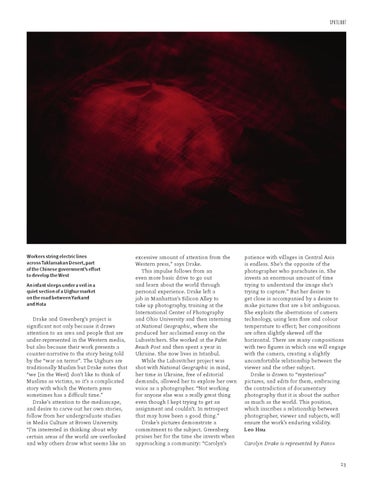Spotlight
Workers string electric lines across Taklamakan Desert, part of the Chinese government’s effort to develop the West An infant sleeps under a veil in a quiet section of a Uighur market on the road between Yarkand and Hota
Drake and Greenberg’s project is significant not only because it draws attention to an area and people that are under-represented in the Western media, but also because their work presents a counter-narrative to the story being told by the “war on terror”. The Uighurs are traditionally Muslim but Drake notes that “we [in the West] don’t like to think of Muslims as victims, so it’s a complicated story with which the Western press sometimes has a difficult time.” Drake’s attention to the mediascape, and desire to carve out her own stories, follow from her undergraduate studies in Media Culture at Brown University. “I’m interested in thinking about why certain areas of the world are overlooked and why others draw what seems like an
excessive amount of attention from the Western press,” says Drake. This impulse follows from an even more basic drive to go out and learn about the world through personal experience. Drake left a job in Manhattan’s Silicon Alley to take up photography, training at the International Center of Photography and Ohio University and then interning at National Geographic, where she produced her acclaimed essay on the Lubavitchers. She worked at the Palm Beach Post and then spent a year in Ukraine. She now lives in Istanbul. While the Lubavitcher project was shot with National Geographic in mind, her time in Ukraine, free of editorial demands, allowed her to explore her own voice as a photographer. “Not working for anyone else was a really great thing even though I kept trying to get an assignment and couldn’t. In retrospect that may have been a good thing.” Drake’s pictures demonstrate a commitment to the subject. Greenberg praises her for the time she invests when approaching a community: “Carolyn’s
patience with villages in Central Asia is endless. She’s the opposite of the photographer who parachutes in. She invests an enormous amount of time trying to understand the image she’s trying to capture.” But her desire to get close is accompanied by a desire to make pictures that are a bit ambiguous. She exploits the aberrations of camera technology, using lens flare and colour temperature to effect; her compositions are often slightly skewed off the horizontal. There are many compositions with two figures in which one will engage with the camera, creating a slightly uncomfortable relationship between the viewer and the other subject. Drake is drawn to “mysterious” pictures, and edits for them, embracing the contradiction of documentary photography that it is about the author as much as the world. This position, which inscribes a relationship between photographer, viewer and subjects, will ensure the work’s enduring validity. Leo Hsu Carolyn Drake is represented by Panos 23
